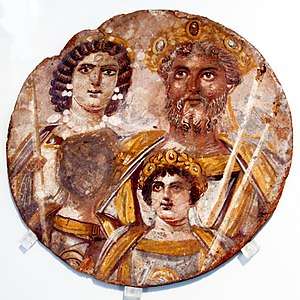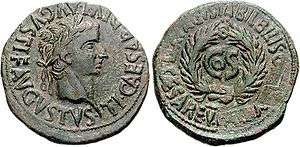Damnatio memoriae

Damnatio memoriae is a modern Latin phrase literally meaning "condemnation of memory", meaning that a person must not be remembered.
It was a form of dishonor that could be passed by the Roman Senate on traitors or others who brought discredit to the Roman State. The intent was to erase all memory of the malefactor.
Etymology
In Latin, the term damnatio memoriae was not used by the ancient Romans. The first appearance of the phrase is in a dissertation written in Germany in 1689. The term is used in modern scholarship to cover a wide array of official and unofficial sanctions whereby the physical remnants of a deceased individual were destroyed to differing degrees.[1][2]
_2012-09-30_008.jpg)
Practice
Damnatio memoriae, or oblivion, as a punishment was originally created by the peoples of Ephesus after Herostratus set fire to the Temple of Artemis, one of the Seven Wonders of antiquity. The Romans, who viewed it as a punishment worse than death, adopted this practice. Felons would literally be erased from history for the crimes they had committed.
The sense of the expression damnatio memoriae and of the sanction is to cancel every trace of the person from the life of Rome, as if they had never existed, in order to preserve the honour of the city. In a city that stressed social appearance, respectability, and the pride of being a true Roman as a fundamental requirement of the citizen, it was perhaps the most severe punishment.

In ancient Rome, the practice of damnatio memoriae was the condemnation of Roman elites and emperors after their deaths. If the senate or a later emperor did not like the acts of an individual, they could have his property seized, his name erased and his statues reworked. Because there is an economic incentive to seize property and rework statues, historians and archaeologists have had difficulty determining when official damnatio memoriae actually took place, although it seems to have been quite rare.
It is unknown whether any damnatio memoriae was totally successful as it would not be noticeable to later historians, since, by definition, it would entail the complete and total erasure of the individual in question from the historical record. It was difficult, however, to implement the practice completely. For instance, the senate wanted to condemn the memory of Caligula, but Claudius prevented this. Nero was declared an enemy of the state by the senate, but then given an enormous funeral honoring him after his death by Vitellius. While statues of some emperors were destroyed or reworked after their death, others were erected. Also, historians often wrote about the deposed emperors. Finally, many coins with the images of the discredited person continued to circulate. A particularly large number exist with Geta's image.[3]
The practice was applied to Elagabalus after his assassination.[4]
See also
| Wikimedia Commons has media related to Damnatio memoriae. |
References
- ↑ Eric R. Varner (2004). Monumenta Graeca et Romana: Mutilation and transformation : damnatio memoriae and Roman imperial portraiture. BRILL. p. 2.
- ↑ Elise A. Friedland; Melanie Grunow Sobocinski; Elaine K. Gazda. The Oxford Handbook of Roman Sculpture. Oxford. p. 669.
- ↑ Geta: The One Who Died Archived December 3, 2010, at the Wayback Machine.
- ↑ Hans Willer Laale, Ephesus (Ephesos): An Abbreviated History From Androclus to Constantine XI (2011) p. 269
